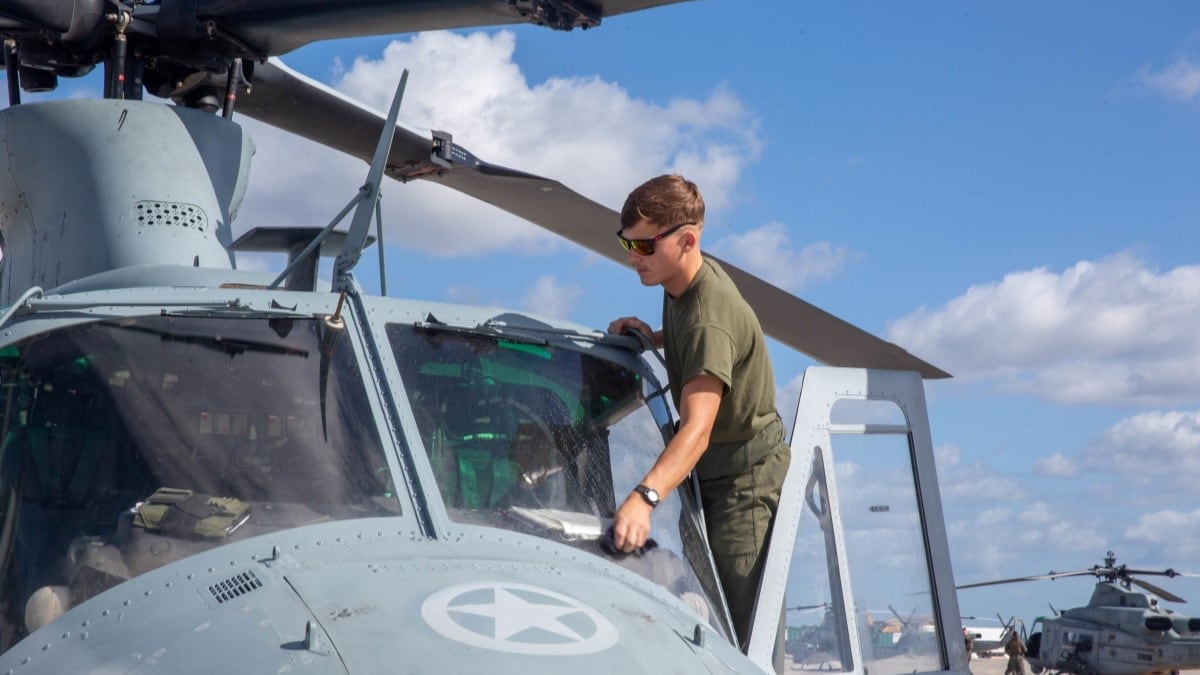In November 2022, Marines from a North Carolina helicopter squadron flew their AH-1Z Vipers and UH-1Y Venoms together for what was supposed to be the last time.
A Marine in one helicopter marked the occasion by making the “rock and roll” hand gesture as the aircraft neared the ground, according to video of the final flight.
The next month, Marines from Marine Light Attack Helicopter Squadron 269, known as the “Gunrunners,” officially cased the unit’s colors in a ceremony aboard Marine Corps Air Station New River, North Carolina.
But less than two years after the squadron was deactivated as part of an overhaul of the Marine Corps, it will get reactivated.
“Through the Force Design Campaign of Learning, the Service continually seeks validation of previous assumptions to ensure the [Fleet Marine Force] is effective, lethal, and combat-ready,” Marine spokesman Maj. Eric Flanagan said in an emailed statement to Marine Corps Times on March 14.
Marine light attack helicopter squadrons, commonly known as HMLAs, would prove useful in crisis-response missions and maritime conflicts with peer adversaries alike, said Flanagan, who noted the “persistent demand” for the squadrons’ capabilities.
The Viper, which can support troops on the ground by firing at targets in the air and on the ground, and the Venom, which can perform a wide range of missions, are both Bell-made helicopters and part of the same family of aircraft, according to Naval Air Systems Command.
Marine Light Attack Helicopter Squadron 269 will get reactivated in July, according to Flanagan.
The December 2022 deactivation took place as part of Force Design 2030, the Corps’ plan for modernizing to meet the threat of technologically sophisticated adversaries like the Chinese military. As part of the plan, the service has gotten rid of some units and assets to free up money for other capabilities.
In the initial 2020 document laying out Force Design 2030, then-Commandant Gen. David Berger called for the Marine Corps to cut at least two of its seven light attack helicopter squadrons.
“While this capability has a certain amount of relevance to crisis and contingency missions which we must still be prepared to execute, it is operationally unsuitable for our highest-priority maritime challenges and excess to our needs with the divestment of three infantry battalions,” Berger wrote.
The deactivation of the squadron “was based on planning assumptions which have since been further refined through the campaign of learning,” Flanagan said.
When the squadron was deactivated, its Marines rotated to other units, and its helicopters and equipment were moved to preservation sites in the United States “to maintain a flexible ready bench for the Service and preserve the ability to make future adjustments,” according to Flanagan.
The California-based Marine Light Attack Helicopter Squadron 469 also was deactivated in December 2022.
The deactivations left five light attack helicopter squadrons in the active component, according to Flanagan: Marine Light Attack Helicopter Squadrons 169, 267, 367 and 369 under the California-based 3rd Marine Aircraft Wing, and just Marine Light Attack Helicopter Squadron 167 under the North Carolina-based 2nd Marine Aircraft Wing.
The active component also has a squadron for training Venom and Viper pilots, and the Reserve has two light attack helicopter squadrons, Flanagan said.
Retired Master Gunnery Sgt. Lawrence F. Reeve Jr., who was serving with the Gunrunners as a maintenance chief when it was deactivated, said he had an inkling even in 2022 that the deactivation wouldn’t last. It was clear that the lone East-Coast-based light attack helicopter squadron ― Marine Light Attack Helicopter Squadron 167 ― wasn’t going to be enough to support the Corps’ needs.
“It was tough to see,” Reeve said of the Gunrunners’ deactivation.
When the Corps revives the unit, the helicopters will be brought back to operation from the sites where they had been preserved since the deactivation, according to Flanagan.
The squadron will be formed with “a significant contingent” of Marines who had been part of the Gunrunners in the past, according to Flanagan. The rest of the squadron’s people will come through the normal staffing processes.
For Reeve, the reactivation of the unit where he spent much of his time in the Corps comes as good news.
Combat has evolved, but Marines on the ground still benefit from having the light attack helicopters supporting them from above, he said.
The retired master gunnery sergeant arrived at Marine Light Attack Helicopter Squadron 269 as a lance corporal in 1994, returned to the squadron for long chunks of his career, deployed to Iraq with the squadron five times and held his retirement ceremony in 2023 from the squadron’s hangar.
In his home in Michigan, he has a host of squadron photos, patches and coins, as well as the tail-rotor blade he received as a gift in 2001 when he departed the unit for recruiting duty, he said.
“The pride of being a Gunrunner was always there,” Reeve said. “I always wanted to be a Gunrunner and never wanted to be anything other than a Gunrunner.”
Irene Loewenson is a staff reporter for Marine Corps Times. She joined Military Times as an editorial fellow in August 2022. She is a graduate of Williams College, where she was the editor-in-chief of the student newspaper.





